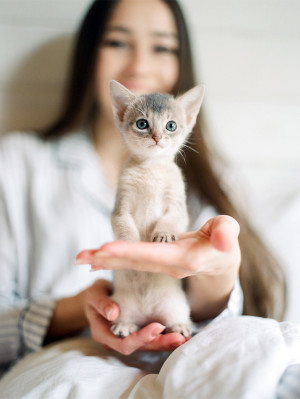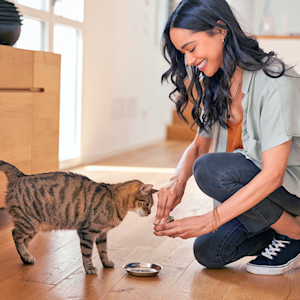When Can Your Kitten Be Spayed?
Learn why vets recommend spaying as early as possible.

Share Article
In This Article:
When Can A Female Kitten Be Spayed? Early Spaying vs. Traditional Timing Benefits of Spaying Kitten Spay Recovery Time and Aftercare Frequently Asked Questions
Traditional guidance suggests waiting until a kitten is six months old. However, many veterinarians now recommend spaying as early as eight to twelve weeks, provided the kitten is healthy and an appropriate weight. An older cat can also be spayed and receive health benefits from this procedure.
Having your female kitten spayed is a recommended part of their health care. A spay is a common term for an ovariohysterectomy, or the surgical removal of the ovaries and uterus. The intention of spaying is to prevent unwanted litters and reproductive health issues. Kittens are typically spayed before being adopted out from a shelter or rescue organization, so most cat parents don’t have to worry about when to spay a kitten. But some new kitten parents are tasked with determining the right time to get their young feline fixed.
When can a female kitten be spayed?
Spaying a kitten “early” — before they’re five months old — is the current recommendation. Kittens can be spayed at any time after they’re eight weeks old, as long as they are healthy enough and weigh enough to undergo anesthesia and surgery.

In recent years, opinions on when to spay a kitten have shifted from a minimum of six months of age to much earlier. There are some commonly used terms to describe the ages of spaying a kitten. Though there is some overlap, the general time frames are:
Pediatric (eight to 12 weeks): Pediatric spays have the benefit of ensuring kittens are spayed before adoption. In the past, kittens were kept in the shelter until they were six months old, or were adopted out with an agreement to have them spayed, which didn’t always happen. This way, the procedure is done before kittens go to a loving home.
Early (eight to 20 weeks): Early spays, the current recommendation, are performed before a kitten experiences her first estrus (heat).
Traditional (six-plus months): Previously, the general consensus was that kittens should wait until at least six months of age, when spay surgery was assumed to be less risky.
Early spaying vs. traditional timing
What is early spaying?
Early spaying means spaying before puberty, or the first heat. Most kittens reach sexual maturity around five months of age, but this can occur as early as four months and as late as six months. An “early” kitten spay is typically performed between four and five months of age, but can be as early as eight weeks, as long as the kitten is both healthy and large enough.
Benefits of early spaying
In 2016, a task force was formed to review the data and come to a consensus on recommended age to spay kittens. They found the most benefit comes from spaying kittens before they are five months old. This led to a “Feline Fix by Five” campaign to spread awareness of the benefits of early spaying. These benefits include:
Eliminating the risk of unwanted pregnancy
Eliminating the risk for reproductive emergencies like uterine infection
Decreasing the risk for mammary cancer
Decreasing the likelihood of undesirable behaviors associated with being in heat
Traditional timing for spaying a kitten
Many veterinarians used to recommend waiting until a kitten was six months old before spaying. The argument for waiting stemmed from a belief that surgery and anesthesia are safer once kittens are older. There were also concerns that early sterilization could contribute to health issues like obesity. Studies have shown that early spays do not have a higher incidence of complications.
When is it too late to spay a cat?
It’s never too late to spay a cat, assuming the cat is healthy enough to be put under anesthesia. In cases of uterine infection or cancer of the reproductive organs, which is typically seen in older adult cats, spaying can be part of treatment.
Can a kitten be spayed when in heat?
A kitten can be spayed while in heat, however, many vets will choose not to perform a spay during this time. The main reason to not spay a cat during this period is because of the increased blood flow to the reproductive organs. There is more blood in the vessels and the tissue is more fragile, which increases the risk of bleeding and tissue damage. Another possible complication is mammary hyperplasia. Due to sudden hormonal shifts, one or more of the mammary glands can become greatly enlarged after spay surgery.
A cat’s heat cycle doesn’t follow a specific schedule, so sometimes a cat will go into heat right before a planned spay surgery. If this is the case, your vet will discuss if it’s best to proceed or postpone the surgery.
Benefits of spaying
Spaying female cats benefits the individual cat, the overall cat population, and cat parents. The main benefits of spaying include:
Population control
There are millions of unwanted and unhoused cats. Some homeless cats are adopted, but many become community nuisances, harm wildlife, contract and spread diseases, or are euthanized. Spaying helps prevent unwanted litters from joining the homeless cat population.
Health benefits
Spaying cats, especially spaying early in life, has been shown to significantly reduce the risk of mammary cancer. One study showed that spaying before a cat reached one year of age reduced the risk of mammary cancer by 86 percent, while spaying even earlier, before six months, reduced the risk by 91 percent. Spaying can be a life-saving measure because most (80 to 96 percent) mammary cancers in cats are malignant, meaning they spread and invade other parts of the body. Spaying cats also:
Eliminates risk of ovarian cancer
Eliminates risk for pyometra (uterine infection)
Eliminates risk of pregnancy-related emergencies (dystocia)
Increases life expectancy (when compared to intact cats)
Behavioral benefits
If you’ve never been around a cat in heat, lucky you. Even the most beloved cat becomes super annoying. Spaying eliminates behaviors associated with estrus (being in heat), including excessive vocalizing, urine spraying, restlessness, and trying to run away to mate. Also, a female cat in heat can literally bring all the boys to the yard, attracting all the loose male cats in the area.
Kitten spay recovery time and aftercare
Most kittens are able to go home the day of a spay surgery, and recovery time is about two weeks. Here’s what to expect and what to do while your kitten recovers from a spay.
The day of surgery
Your kitten will likely still be a little woozy from the anesthesia and medications, so they should not be left unattended. She may be sleepy, glassy-eyed, slow to move, and a little grumpy.
It’s typically okay to feed your kitten two to six hours after surgery. For the first meal, offer only one-fourth to one-half the normal amount of food. Mild nausea is common after anesthesia, so don’t be alarmed if they ignore or just pick at their food the first day.
24 hours after surgery
Your kitten should feel well enough to eat. They should be comfortable enough to walk around and carry out normal activities like going to the food dish and using the litter box.
Let your kitten walk around, but not be too active. Keep them confined to a small room.
Two to 14 days after surgery
By this time, some kittens may feel pretty spry and ready to play at full speed. Don’t allow your kitten to run, jump, or play excessively. Rigorous activity can put too much stress on the sutures and cause abnormal opening of a skin or internal incision. Dehiscence, which is the abnormal opening of a wound or incision, can require additional surgery to repair.
Keep an eye on your kitten’s skin incision. You may notice mild redness or swelling. This is normal. Don’t let your kitten lick the skin incision. A cone(or post-op pajamas) should be worn while your kitten recovers. Days three through seven of recovery are when things get itchy, so make sure your kitten doesn’t have access to their incision, even if they ignored it early on.
Keep your kitten’s recovery area clean, but don’t bathe them. If they get messy, give them a sponge bath and avoid getting the incision wet or soiled. Using a low-dust, non-clumping litter is often recommended to prevent it from sticking to the incision.
14 days after surgery
Depending on the type of suture used, you may have a follow-up appointment for suture removal. This is not required if your vet used absorbable suture to close the skin incision.
After this, your kitten can return to their previously scheduled programming.
When to see your veterinarian
If you have any doubts or concerns during the recovery process, contact your vet. A staff member can assist you on whether what you’re seeing at home is a cause for concern or not. Symptoms that warrant a visit include:
Opening or gaping of the skin incision
Excessive swelling, redness, or bruising
Discharge from the incision
Active bleeding from the incision
Weakness
Pale gums
Uncontrolled pain
Vomiting
Anorexia
FAQs (People also ask):
How much does it cost to spay a kitten?
Cost to spay a kitten can vary widely, from as little as $30 to more than $500. The cost depends on many factors, including pre-surgery screening, monitoring equipment, and having it performed at a private practice versus a non-profit organization.
Why should you spay your cat?
You should spay your cat to prevent unwanted pregnancy, protect them from reproductive-related illnesses like uterine infection, decrease their risk for developing mammary cancer, and spare you both from having to endure them being in heat.
References:

Dr. Alycia Washington, DVM, MS
Alycia Washington is a small-animal emergency veterinarian with over 10 years of experience based in North Carolina. She works as a relief veterinarianopens in new tab and provides services to numerous emergency and specialty hospitals. She also works as a veterinary writer with a focus on educating pet parents.
Related articles
When Can a Kitten Leave Their Mom?
And why it’s important for their health to stay with her as long as possible.
What Can I Feed a Kitten?
Learn what nutrients are a must for your new little one.
![Woman bottle feeding kitten.]()
How to Bottle-Feed a Kitten
Starting with the supplies you’ll need.
![Kitten on a scale]()
How to Help a Kitten Gain Weight
Of course, always talk to your vet first.
![Kitten eating dry food from a bowl.]()
Can a Kitten Eat Dry Food?
And the nutrients you should make sure they’re getting.
Kitten Teething: Do Kittens Lose Their Teeth?
Get those little chompers ready for the kitten tooth fairy.
![Woman feeding her kitten.]()
When Can a Kitten Eat Wet Food?
And how to know what kind they need.
![Woman holding her young kitten in her arms outside.]()
How to Determine a Kitten’s Age
There are a few factors to consider.
![Woman playing with a black kitten.]()
5 Kitten Behavioral Milestones You Should Know
Keep track of all their fun phases with these guidelines.
![Young woman showing gray kitten.]()
5 Development Stages You Should Know When You Get a Kitten
What to expect from birth to 16 months.












